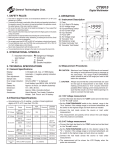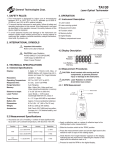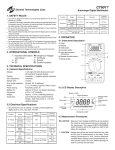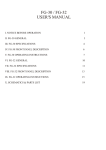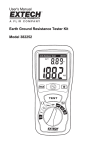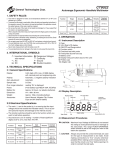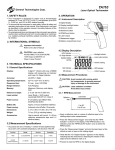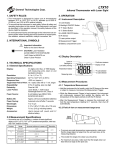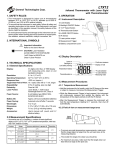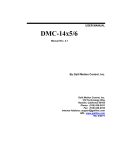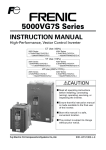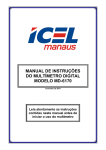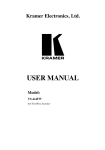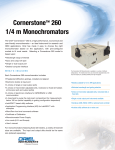Download User`s Manual (PDF 324K)
Transcript
CT8025 General Technologies Corp. Automotive Digital Multimeter 1. SAFETY RULES • This meter is designed for indoor use at temperatures between 0°C to 40°C and • • • • • • • • • altitudes up to 2,000m. To ensure that the meter is used safely, follow all safety and operating instructions in this operation manual. If the meter is not used as described in this operation manual, the safety features of this meter might be impaired. Do not use the meter if the meter or test leads look damaged ,or if you suspect that the meter is not operating properly. When using the instrument, keep your fingers behind the finger guards on the plastic casing and probes. Disconnect the live test lead before disconnecting the common test lead. Make sure power is off before cutting, desoldering, or breaking the circuit wires. Small amounts of current can be dangerous. Do not apply more than 600 VDC or 600V AC rms between a terminal and ground. To avoid electrical shock, use CAUTION when working above 60V DC or 25V AC rms. Such voltages pose a shock hazard. Never make measurements with the battery cover off. To avoid electrical shock or damage to the meter, do not exceed the input limits. 2. INTERNATIONAL SYMBOLS Important information see manual AC DC Dangerous Voltages Continuity Ground Double Insulation 3. TECHNICAL SPECIFICATIONS 3.1 General Specifications Display: Polarity: Zero adjustment: Sample rate: Over range indication: Power: Battery life: Dimension: Weight: Accesories: 3-1/2 digits LCD, max. of 1999 display Automatic, (-) negative polarity indication Automatic 0.5 Sec. “1” or “-1” is displayed 9-volt battery type NEDA 1604, IEC6F22 Approx. 50 hours. (w/ alkaline batteries) 5.55”x2.71”x1.41” or 141x 69x36 mm. Approx. 6.7 Oz or 190g (with battery). User’s Manual, Test Leads, Protective Holster, Soft Pouch, K-type temperature probe and 9V battery 3.2 Electrical Specifications • Accuracies are ±(% of reading + number of least significant digits) at 23°C ±5°C, less than 75% RH. Function Range Accuracy Input Impedance Remarks Overload Protection DC Voltage 20V, 600V 0.8%+2 1 MΩ - 600 Vp-p AC Voltage 600V 1.5%+5 450 KΩ 40~400Hz 600 Vp-p 10A 2.0%+5 - 2000Ω, 20kΩ 0.8%+3 - Resistance 200kΩ, 2MΩ 1.5%+5 - 20MΩ 3.0%+10 - Tachometer 500 to 10000 RPM 0.8%+2 DC Current 10 A - 250V Fuse 3.2V max. test Voltge Test time: 20 Sec. 250 Vp-p 250Vp-p Function Temperature ºF Version Dwell Angle Input Impedance Range Accuracy 32 to 104ºF 3.0%+1 Built in Sensor Overload Protection Remarks -40 to 752ºF 0.75%+3 3.0%+10 K-Type Thermocouple Probe - 752 to 1832ºF 3 to 8 Cyl. 0-120º 1.5%+2 0.1º Resoultion 250 Vp-p Continuity Buzzer sounds when <100Ω Test Voltage: 2.4 V Max. 250 Vrms Diode Test Test Current:1.0±0.6mA Test Voltage: 2.4 V Max. 250 Vrms 4. OPERATION 4.1 Instrument Description 1) Case � 2) 3-1/2 Digit LCD display � 3) Power OFF position 4) Tachometer function 5) Function/Range Switch � 6) Temperature function � 7) Resistance function 8) Temperature probe socket � 9) Input and common connector 10) DC Voltage function � 11) AC Voltage function � 12) DC Current function � 13) Dwell function � � ���� ����� ��� ��� ����� � �� � � � D WELL � �� �� �� �� TEMP �C ��� ��� ��� ����� � � ��� ���� � 4.2 Measurement Procedures CAUTION: Maximum Input Voltage is 600Vrms,do not exceed this rating to avoid personal injuries or damage to the instrument. The range FUNCTION/RANGE switch should be set to the range you want to test before the operation. CAUTION: Always ensure that the correct terminals are used for the type of measurement to be made. Avoid making connections to “live” circuits whenever possible.When making current measurements ensure that the circuit is not “live” before opening it in order to connect the test leads. 4.2.1 DC Voltage measurement • Connect the black test lead to the “COM” socket and red test lead to the “V Ω” socket. • Set the FUNCTION/RANGE switch to the desired range in the “V ” function. If the voltage range is not known beforehand, set the switch to the highest range and work down as needed. • Connect the test leads across the source or load under measurement. • The measurement and polarity will be shown the LCD Display when the probe are connected. 4.2.2 AC Voltage measurement • Connect the black test lead to the “COM” socket and red test lead to the “V Ω” socket. • Set the FUNCTION/RANGE switch to the desired range in the “V ” function. • Connect the test leads across the source or load under measurement. • The measurement will be shown in the LCD Display when the probe are connected. 4.2.3 DC Current measurement • Connect the black test lead to the “COM” socket and red test lead to the “A” input connector. . • Set the FUNCTION/RANGE switch to the “A ” function. • Connect the test leads in series with the source or load under measurement. • The measurement and polarity of the current will be shown the LCD Display when the current is flowing through the instrument. 4.2.4 Resistance measurement CAUTION: Maximum Input Voltage for this function is 250 Vrms for less than 10 Sec., do not exceed this rating to avoid personal injuries or damage to the instrument. Also ensure there is no power applied to the component or circuit and all capacitors are discharged. • Connect the black test lead to the “COM” socket and red test lead • When the Function/Range switch is set to the “TEMP” position, and no external thermocouple is connected, the meter will automatically measure ambient temperature. 4.3 Other Functions 4.3.1 Diode/Continuity test CAUTION: Maximum Input Voltage for this function is 250 Vrms for less than 10 Sec., do not exceed this rating to avoid personal injuries or damage to the instrument. Also ensure there is no power applied to the diode. • Connect the black test lead to the “COM” socket and red test lead to the “V Ω” socket. • Set the FUNCTION/RANGE switch to the “2000 Ω function. ” within the • For diode testing proceed to connect the test leads across the diode observing the polarity: red probe to the anode (+) of the diode and black test lead to the cathode (-) . • For continuity test proceed to connect the test leads across the circuit or component, the buzzer will sound if the circuit resistance is below 100Ω. to the “V Ω” socket. • Set the FUNCTION/RANGE switch to the desired range in the “Ω” function. If the resistancege range is not known beforehand, set the switch to the highest range and work down as needed. • Connect the test leads across the componet or circuit under measurement. • The measurement will be shown in the LCD Display when the probe are connected. 5.1 Battery Replacement 4.2.5 Tach (RPM) Measurement • To replace the battery, remove the screw of the back Battery Cover CAUTION: Maximum Input Voltage for this function is 250 Vrms for less than 10 Sec., do not exceed this rating to avoid personal injuries or damage to the instrument. • Connect the black test lead to the “COM” socket and red test lead to the “V Ω” socket. • Set the FUNCTION/RANGE switch to the corresponding number of cylinders of the engine to test in the “TACH” function. • Connect the black test lead to to the vehicle ground or negative (-) terminal of the battery, and the red test lead to the breaker point of the distributor or negative (-) terminal of the ignition coil. • The RPM will be shown in the LCD Display when the engine is running. 4.2.6 Dwell Angle Measurement CAUTION: Maximum Input Voltage for this function is 250 Vrms for less than 10 Sec., do not exceed this rating to avoid personal injuries or damage to the instrument. • Connect the black test lead to the “COM” socket and red test lead to the “V Ω” socket. • Set the FUNCTION/RANGE switch to the corresponding number of cylinders of the engine to test in the “Dwell” function. • Connect the black test lead to to the vehicle ground or negative (-) terminal of the battery, and the red test lead to the breaker point of the distributor or negative (-) terminal of the ignition coil. • The Dwell angle will be shown in the LCD Display when the engine is running. 4.2.6 Temperature Measurement • Set the FUNCTION/RANGE switch to the “TEMP” position. • Connect the K-type thermocouple probe connector into the Temperature socket observing the polarity of the connector and socket. 5. MAINTENANCE CAUTION: Before attempting battery removal or replacement, disconnect test leads and remove the instrument from any energized circuit to avoid shock hazard. (back of the case) and remove the battery. • Replace with a new 9 V alkaline battery type NEDA 1604 or IEC6F22 observing the proper polarity from the diagram on the label inside the battery compartment. • Reinstall the battery cover and tighten the securing screw. 5.2 Fuse replacement • Remove the screw of the back Battery Cover (back of the case) and remove the battery. • Remove the screws at the bottom of the case and of the battery compartment. • Replace new fuse only with the identical type and rating. F2=10A: Type IEC60127-2 orUL248-14 (6.3x25.4mm) fast acting fuse, rated at 10A/250V. • Reinstall the back cover, and replace the four screws, • Reinstall the battery observing the polarity on the battery compartment label, the battery cover and tighten the securing screw. 5.3 Cleaning Periodically wipe the case with a soft damp cloth and mild household cleanser. Do not use abrasives or solvents. Ensure that no water gets inside the instrument to prevent possible shorts and damage. 6. WARRANTY One year limited warranty, excluding batteries and fuses. For details see Standard Warranty Information in our webpage or request a printed copy. General Technologies Corp. #121 - 7350 72nd Street Delta, BC Canada V4G 1H9 Tel.: (604) 952-6699 Fax: (604) 952-6690 www.generaltechnologies.net © Copyright 2001 General Technologies


